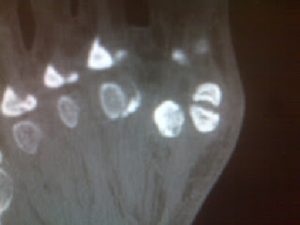Sesamoiditis is a painful condition that affects the area of your foot beneath you big toe. Sesamoid bones are small accessory bones that reside under your first metatarsal and function as an additional lever arm to help propel you forward during walking and running. With repetitive impact a walker or runner may start to experience pain in their sesamoid bones. This pain can be due to;

- Inflammation of the Sesamoid bone(s)
- Inflammation of the Distal Plantar Fascia as it envelops the Sesamoid bones
- Fracture of the Sesamoid bone(s)
- Bone Marrow Edema in the Sesamoid Bones
- Some other condition that affects the first toe joint such as gout. It has been my experience that many patients with Gout have been misdiagnosed with Sesamoiditis! Gout is an autoimmune disorder that affects the first metatarsal joint but is due to the accumulation of Uric Acid crystals and not because of inflammation of the Sesamoid bones. A simple blood or urine test can help shed light on whether or not you suffer from gout.

X-Ray of Bi-Partite Sesamoid Bones
There is a genetic anomaly known as Bi-Partite Sesamoid bone(s). In this phenomenon a persons sesamoid bone(s) never fuse during childhood resulting in the appearance of an extra bone. This extra bone is also often confused as a fractured sesamoid bone. I have seen a few patients that were diagnosed with a fractured Sesamoid bone who in fact were suffering from Gout! Gout can be accurately diagnosed using a simple urine or blood test.
After an accurate diagnosis is reached it is easy to formulate an effective treatment plan for the injured patient. When the injury is not too severe I can usually make a custom orthotic or sometimes customize an existing orthotic using an accommodation known as a Dancer’s Pad. This pad can help offload the pressure causing the pain in the patient’s Sesamoid bone(s).
An elite young female soccer player came in the office today complaining of chronic turf toe and sesamoid pain. She had received 6 months of physical therapy and had multiple pairs of custom orthotics made. The main issue was that the custom orthotics were either not comfortable, not effective or did not fit into her shoes well making them not practical.
Why did the custom orthotics I receive not help and may seem to have made it worse?
Custom orthotics are made by first taking a mold of your foot. Then various modifications are made to the mold to offset the pressure which is causing the pain. Unfortunately, many patients go to doctors and therapists and receive ONLY a mold of their foot without modifications. They believe they received a custom orthotic……they did not. They simply received a mold of their foot. For years I have been taking ineffective or uncomfortable molds other doctors have made and modifying them for the patient making them both comfortable and effective.
How do I make an appointment with your clinic and how long does it take to modify my orthotics?
You can call 858-268-8525 OR email drallen@sdri.net OR text 858-322-8582 requesting an appointment. Please provide dates and times you are requesting for an appointment. Someone will get back to you shortly to schedule. If you do not live in the San Diego area we may still be able to help you with either a phone or online Zoom consult or by having you mail us your orthotics for modification.

Leave A Comment